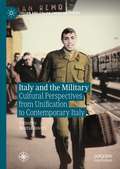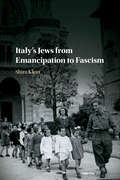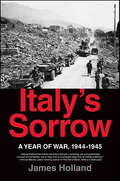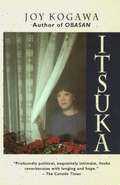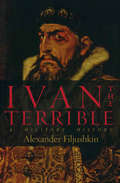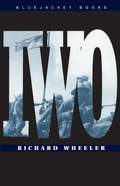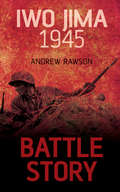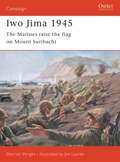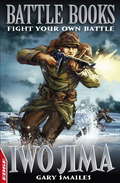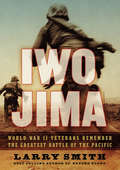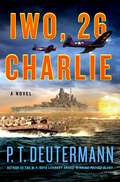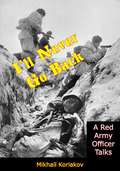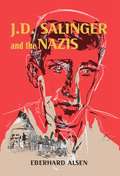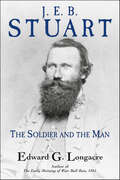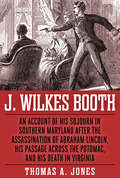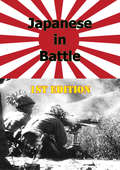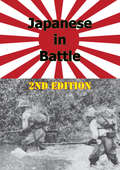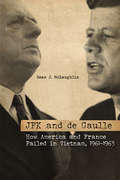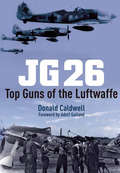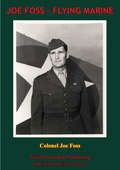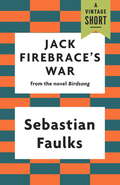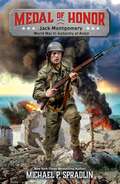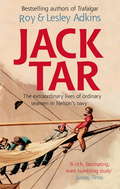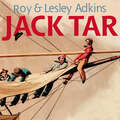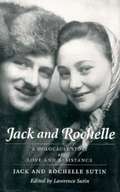- Table View
- List View
Italy and the Military: Cultural Perspectives from Unification to Contemporary Italy (Italian and Italian American Studies)
by Mattia RoveriThis book sheds new light on the role of the military in Italian society and culture during war and peacetime by bringing together a whole host of contributors across the interdisciplinary spectrum of Italian Studies. Divided into five thematic units, this volume examines the continuous and multifaceted impact of the military on modern and contemporary Italy. The Italian context offers a particularly fertile ground for studying the cultural impact of the military because the institution was used not only for defensive/offensive purposes, but also to unify the country and to spread ideas of socio-cultural and technological development across its diverse population.
Italy's Jews from Emancipation to Fascism
by Shira KleinHow did Italy treat Jews during World War II? Historians have shown beyond doubt that many Italians were complicit in the Holocaust, yet Italy is still known as the Axis state that helped Jews. Shira Klein uncovers how Italian Jews, though victims of Italian persecution, promoted the view that Fascist Italy was categorically good to them. She shows how the Jews' experience in the decades before World War II - during which they became fervent Italian patriots while maintaining their distinctive Jewish culture - led them later to bolster the myth of Italy's wartime innocence in the Fascist racial campaign. Italy's Jews experienced a century of dramatic changes, from emancipation in 1848, to the 1938 Racial Laws, wartime refuge in America and Palestine, and the rehabilitation of Holocaust survivors. This cultural and social history draws on a wealth of unexplored sources, including original interviews and unpublished memoirs.
Italy's Sorrow: A Year of War, 1944-1945
by James HollandIn a chilling history, renowned historian James Holland deftly relates Italy's dark forgotten years During the Second World War, the campaign in Italy was the most destructive fought in Europe - a long, bitter and highly attritional conflict that raged up the country's mountainous leg. For frontline troops, casualty rates at Cassino and along the notorious Gothic Line were as high as they had been on the Western Front in the First World War. There were further similarities too: blasted landscapes, rain and mud, and months on end with the front line barely moving. And while the Allies and Germans were fighting it out through the mountains, the Italians were engaging in bitter battles too. Partisans were carrying out a crippling resistance campaign against the German troops but also battling the Fascists forces as well in what soon became a bloody civil war. Around them, innocent civilians tried to live through the carnage, terror and anarchy, while in the wake of the Allied advance, horrific numbers of impoverished and starving people were left to pick their way through the ruins of their homes and country. In the German-occupied north, there were more than 700 civilian massacres by German and Fascist troops in retaliation for Partisan activities, while in the south, many found themselves forced into making terrible and heart-rending decisions in order to survive.Although known as a land of beauty and for the richness of its culture, Italy's suffering in 1944-1945 is now largely forgotten. Italy's Sorrow by James Holland is the first account of the conflict there to tell the story from all sides and to include the experiences of soldiers and civilians alike. Offering extensive original research, it weaves together the drama and tragedy of that terrible year, including new perspectives and material on some of the most debated episodes to have emerged from World War II.
Itsuka
by Joy KogawaAlready a Canadian bestseller, "Itsuka," the sequel to Joy Kogawa's award-winning novel "Obasan," follows the character Naomi Nakane into adulthood, where she becomes involved in the movement for governmental redress. Much more overtly political than Kogawa's first novel, the story focuses on reaching that Itsuka - someday - when the mistreatment of those of Japanese heritage during World War II would be recognized. Although during the war both the United States and Canada interned Japanese-Americans and confiscated their property, when the war ended the property of those in Canada was never returned to them. Itsuka is the story of the fight to get government compensation for the thousands of victims of the wartime internment, which was, unbelievably, only just accomplished in 1988. Both a moving novel of self-discovery and a fascinating historical account of the fight for redress, Itsuka's final message is one of inspiration and hope.
Ivan the Terrible: A Military History
by Alexander FiljushkinAn in-depth look at the military strategy of the first Russian ruler to invade Europe. Ivan&’s campaigns against the Livonian Confederation were initially very successful. In 1558, Russian soldiers occupied Dorpat and Narva, and laid siege to Reval, creating vital trade routes over the Baltic Sea. At the Battle of Ergema, the Russians defeated the knights of the Livonian Order, fueling Ivan&’s dreams of a Russian Empire. However, as Erik XIV of Sweden recaptured Reval, and the Poles joined forces with the Lithuanians, the war began to turn against Ivan. In 1571, an army of 120,000 Crimean Tatars crossed the River Ugra, crushed the Russian defenses, and burned Moscow to the ground. As Ivan became increasingly paranoid and violent, he carried out a number of terrible massacres. It is thought that more than forty thousand were killed when the Russians sacked the town of Novgorod in 1570, and many were tortured and murdered in front of Ivan and his son. This book describes the organization and equipment of the tsar&’s army and the forces of his enemies, the Poles, Lithuanians, Tatars, and Livonian Knights. The narrative examines all of Russia&’s military campaigns in Eastern Europe and Western Siberia during the period of 1533 to 1584—in the first specialist study of Ivan the Terrible&’s military strategy to be published in English.
Iwo
by Richard WheelerThe story of one of the bloodiest battles in history, resulting in the raising of the American flag on Mt. Suribachi, is documented with a personal touch; the author himself was a member of that company. It is a searing and unique account of that battle, told from the perspective of both the gallant U.S. Marines who invaded the island and the brave Japanese soldiers who defended it.
Iwo Jima 1945
by Andrew RawsonOne of the bloodiest battles of the war in the Pacific. Operation Detachment, the invasion of Iwo Jima, on February 19, 1945, was the first campaign on Japanese soil, and it resulted in some of the fiercest fighting of the Pacific campaign. United States Marines supported by the U.S. Navy and Air Force fought the Japanese both over and underground on the island of volcanic ash, in a battle which was immortalized by the raising of the Stars and Stripes above Mount Suribachi. It was a battle that the Japanese could not win, but they were determined to die trying; of the 18,000-strong garrison, only 200 were taken prisoner. The Americans lost more in the 35-day battle, but at the end they had possession of three airfields in range of the Japanese mainland. This book gives a clear, concise account of those dramatic days in 1945, supported by a timeline of events and orders of battle. Over fifty photographs illustrate the events during this momentous battle.
Iwo Jima 1945
by Jim Laurier Derrick WrightOne of the decisive battles of World War II (1939-1945) in the Pacific, Iwo Jima was described by Lieutenant-General Holland Smith, Commander Fleet Marine Forces Pacific, as "The most savage and most costly battle in the history of the Marine Corps" - a titanic struggle that eclipsed all that had gone before. Situated halfway along the B-29 Superfortress route to the Japanese mainland, the island was of major strategic importance to the US Air Force, but also to the Japanese, 20,000 of whom were deeply entrenched in the island. This book provides a definitive account of the battle, from its origins to its hard-fought conclusion.
Iwo Jima: Fight Your Own Battle (EDGE: Battle Books #3)
by Gary SmailesTake up your weapons and prepare to fight your own battle in these all-action, interactive adventures, in which you take part in epic battles from throughout history.It is 1945 and though Nazi Germany has been defeated, World War II rages on as Japan continues to fight. The US Marines have fought their way across the Pacific Ocean, defeating Japanese forces one small island at a time. The fighting has now reached Iwo Jima, a rocky volcanic island only 600 miles from Japan.You are a US Marine just about to land on the steep beaches of Iwo Jima. You must fight across the black sand to knockout the sea guns based there and take the island...
Iwo Jima: World War II Veterans Remember the Greatest Battle of the Pacific
by Larry Smith"A vivid and compelling account by a true master of oral history." --General James L. Jones, USMC (Ret.), Supreme Allied Commander, Europe On February 19, 1945, nearly 70,000 American marines invaded a tiny volcanic island in the Pacific. Over the next thirty-five days, approximately 28,000 combatants died, including nearly 22,000 Japanese and 6,821 Americans, making Iwo Jima one of the costliest battles of World War II. Bestselling author Larry Smith lets twenty-two veterans tell the story of this epic clash in their own words; the result is a "superb and fascinating work by one of our nation's leading oral historians" (Jay Winik, author of April 1865). Iwo Jima includes accounts from the last surviving flag raiser on Mount Suribachi, a Navajo code talker, a retired general, two Medal of Honor recipients, and B-29 flyers. With numerous photographs and maps, Iwo Jima is a stunning history of an emblematic battle and a powerful, personal history of this greatest generation of marines.
Iwo, 26 Charlie: A Novel (P. T. Deutermann WWII Novels)
by P. T. DeutermannThe tiny Pacific island of Iwo Jima was the focus of an epic land and sea battle that produced one of the most iconic images of World War II: US Marines raising the American flag on Mount Suribachi, an active volcano where American and Japanese soldiers, desperate to secure the island’s airfields, fought hand to hand and always to the death. In this gripping novel, award-winning author and retired commodore P. T. Deutermann follows a young Navy gunnery officer stationed on the battleship Nevada from the beginning of the battle to its decisive end.Lieutenant Lee Bishop serves in the main plotting room aboard USS Nevada, targeting fourteen-inch shells from the ship’s guns against enemy positions on Iwo Jima called in by frantic Marine spotters ashore. But after the Marines suffer devastating losses of spotting personnel to the Japanese hunting teams sent out specifically to kill them, Bishop volunteers to serve onshore as a replacement, calling in coordinates to target Japanese positions with offshore naval gunships, such as Nevada.But Bishop is completely unprepared for what he witnesses and experiences: a literal hell on earth, during which twenty-six thousand Americans become casualties in desperate and often hand-to-hand fighting with the enemy garrison, men committed to dying for Japan. Bishop goes from the safe, air-conditioned gunnery control spaces of a battleship to the mud, blood, and sheer terror of night fighting against suicidal Japanese who come out of the night and leap into Marine foxholes with samurai swords to slaughter American Marines. The battle culminates on the stinking slopes of the volcano, where Bishop calls in monster projectiles against banzai charges while using a Thompson submachine to save his own life and those of his fellow Marines.Iwo, 26 Charlie is a frighteningly dramatic, utterly authentic novel by an award-winning writer and Navy veteran who is a contemporary master of World War II military fiction.
I’ll Never Go Back: A Red Army Officer Talks
by Mikhail Koriakov Nicholas WredenIn the spring of 1944, Red Army Air Force military correspondent Mikhail Koriakov experienced a profound religious awakening which led to a sudden marked revulsion in his entire opinion of the Soviet system and philosophy. On voicing his new views, he was regarded to be “ideologically unsound,” was relieved of his post, and assigned to innocuous duties.I’ll Never Go Back, first published in 1948, details the author’s adventures following his conversion. The book provides a starkly realistic account of the brutality of the Red Army, detailing various incidents of barbarisms to which he was witness, and also describes his assignment to the Embassy and the operations of the Soviet secret police (NKVD) in Paris during this period.“…compelling…”—Kirkus Review
J. D. Salinger and the Nazis
by Eberhard AlsenBefore J.D. Salinger became famous for his 1951 novel The Catcher in the Rye and infamous as a literary recluse, he was a soldier in World War II. While serving in the U.S. Army's Counter Intelligence Corps (CIC) in Europe, Salinger wrote more than twenty short stories and returned home with a German war bride. Eberhard Alsen, through meticulous archival research and careful analysis of the literary record, corrects mistaken assumptions about the young writer's war years and their repercussions. Though recent biographies and films claim that Salinger regularly participated in combat, Alsen cites military documents showing that his counterintelligence work was well behind the front lines. Alsen, a longtime Salinger scholar who witnessed the Nazi regime firsthand as a child in Germany, tracks Salinger's prewar experiences in the army, his work for the CIC during significant military campaigns, and his reactions to three military disasters that killed more than a thousand fellow soldiers in his Fourth Infantry Division. Alsen also identifies the Nazi death camp where Salinger saw mounds of recently burned bodies. Revealing details shed light on Salinger's outspoken disgust for American military leaders, the personality changes that others saw in him after the war, and his avoidance of topics related to the Holocaust.
J. E. B. Stuart: The Soldier and the Man
by Edward G. LongacreEdward Longacre provides a balanced portrait of the Civil War's famed cavalryman, J. E. B. Stuart, debunking myths to reveal a complex man known for both his military brilliance and personal flaws. Fifteen years have passed since the publication of the last biography of Jeb Stuart. Several appeared during the last century lauding his contributions to Confederate fortunes in the Eastern Theater. Each follows a familiar tradition established by hero-worshipping subordinates portraying its subject as a model of chivalric conduct with a romantic’s outlook on life and a sense of fair dealing and goodwill, even toward his enemy. J. E. B. Stuart: The Soldier and the Man, by award-winning author Edward Longacre, is the first balanced, detailed, and thoroughly scrutinized study of the life and service of the Civil War’s most famous cavalryman. Long known to scholars and history buffs alike as “The Beau Sabreur of the Confederacy,” James Ewell Brown Stuart of Virginia was possessed of many gifts, personally and professionally, and led the Army of Northern Virginia’s cavalry to the all-but-complete satisfaction of his superiors. Stuart, insisted Robert E. Lee, “never brought me a piece of false information.” Being human, Stuart also under-performed. On occasion, he underestimated his opponents, took unnecessary risks with his habitually understrength command, failed to properly discipline and motivate his troopers, and was prone to errors both strategic and tactical. These flaws were evident during the Gettysburg Campaign, when his wayward route to the battlefield deprived Lee of the ability to safely negotiate his path toward a climactic confrontation with the Union Army of the Potomac. Because of his outsized wartime reputation—one embellished in the century-and-a-half since—most of Stuart’s errors have passed virtually unnoticed or, when addressed, have been excused or explained away in some fashion. Longacre’s study is based on hundreds of published works, archival sources, and newspapers. He probes not only Stuart’s military career but elements of his character and personality that invite investigation. Even the man’s fiercest partisans admitted that he was vain and inordinately sensitive to criticism, with a curious streak of immaturity—at times the hard-edged veteran, at other times a devotee of the pageantry of war, given to affectations such as ostrich-plumed hats, golden spurs, and the headquarters musicians who accompanied him on the march. Ever motivated by appeals to vanity, he curried the patronage of powerful men and responded readily to the attentions of attractive women even though by 1861, he was a long-married man. Personal flaws and limitations aside, Stuart was popular with his officers and men, beloved by members of his staff, and considered by the people of his state and region the beau ideal of Confederate soldiery. The distinction endures today. Longacre’s J. E. B. Stuart is an attempt to determine its validity.
J. Wilkes Booth: An Account Of His Sojourn In Southern Maryland After The Assassination Of Abraham Lincoln, His Passage Across The Potomac, And His De
by Thomas JonesJ. Wilkes Booth: An Account of His Sojourn..., first published in 1893, is the straight-forward account of the doomed escape of John Wilkes Booth following his assassination of Abraham Lincoln. The book was written by Thomas Jones, a Confederate agent who helped Booth evade the authorities for five days by hiding the assassin near his house in Maryland. Illustrated with 18 pen and ink illustrations.
JAPANESE IN BATTLE 1st Edition [Illustrated Edition] (JAPANESE IN BATTLE #1)
by Military Intelligence Staff GHQ IndiaIllustrated with more than 20 maps plans and photos.When this handbook was written in 1943 the Japanese soldier was seen by British Empire troops as a jungle fighting superman, who had largely blitzed and defeated them at every turn. As part of an effort to dispel this myth the Intelligence Section of General Headquarters in India set about distilling the tactics that the Japanese had used and to formulate counter-measures. As the staff point out in their introduction;"The Japanese are an island race who have mastered the art of war, not through any mysterious or indefinable quality inherited from their Emperor, their islands, or their ancestors during your grandfather's time they were still in the bow-and-arrow stage-but through serious study of ancient and modern methods, and by intensive training. If we analyse their tactics, reducing them to fundamentals, all that they practise is to be found in our own training manuals, or in the military histories of ancient campaigns; not even the snipers in the trees are new-the jungle tribes of Africa and Brazil have employed them since time immemorial."In their long history the peoples of our Empire have shown the world that they possess more than an average share of courage and tenacity, and today we must add to these advantages our undoubted superiority in arms and equipment. Any success which the Japanese have had against us was due to intensive training, carefully rehearsed plans and normal guts. Whatever the task in hand-be it the digging of a single fox-hole or the preparation of a large-scale invasion-their work is done with meticulous care, and by intensive and sustained training alone can we hope to outmanoeuvre them."As close to a handbook in English of how the Japanese fought and won their battles in the jungles of Southeast Asia at the beginning of the Second World War: A fascinating read.
JAPANESE IN BATTLE 2nd Edition [Illustrated Edition] (JAPANESE IN BATTLE #2)
by Military Intelligence Staff GHQ IndiaIllustrated with more than 30 maps plans and photos.Written in August 1944 when the Japanese Imperial armies had tasted their first bitter defeats in Burma; the staff of GHQ India were determined to record all of the lessons learned and ensure that the troops in the field would profit from the knowledge. A brilliant exposition of the Japanese methods of land warfare in the later stages of the Second World War as can be found.Although titled as a second edition, this World War Two briefing book is in fact almost completely different from the first Edition.
JFK and de Gaulle: How America and France Failed in Vietnam, 1961–1963 (Studies in Conflict, Diplomacy, and Peace)
by Sean J. McLaughlin“America’s road to disaster in Vietnam has been endlessly chronicled, but Sean L. McLaughlin takes a fresh approach to that familiar story.” —James Hershberg, George Washington UniversityDespite French President Charles de Gaulle’s persistent efforts to constructively share French experience and use his resources to help engineer an American exit from Vietnam, the Kennedy administration responded to de Gaulle’s peace initiatives with bitter silence and inaction.The administration’s response ignited a series of events that dealt a massive blow to American prestige across the globe, resulting in the deaths of over fifty-eight thousand American soldiers and turning hundreds of thousands of Vietnamese citizens into refugees.This history of Franco-American relations during the Kennedy presidency explores how and why France and the US disagreed over the proper western strategy for the Vietnam War. France clearly had more direct political experience in Vietnam, but France’s postwar decolonization cemented Kennedy’s perception that the French were characterized by a toxic mixture of shortsightedness, stubbornness, and indifference to the collective interests of the West.At no point did the Kennedy administration give serious consideration to de Gaulle’s proposals or entertain the notion of using his services as an honest broker in order to disengage from a situation that was rapidly spiraling out of control. Kennedy’s Francophobia, the roots of which appear in a selection of private writings from Kennedy’s undergraduate years at Harvard, biased his decision-making. This book explores how the course of action Kennedy chose in 1963, a rejection of the French peace program, all but handcuffed Lyndon Johnson into formally entering a war he knew the United States had little chance of winning.
JG26: Top Guns of the Luftwaffe
by Donald Caldwell&“This unique, impressive study presents a history in microcosm of the entire Luftwaffe Fighter Corps . . . [a] spellbinding work.&” —Library Journal Jagdgeschwader 26, the German elite fighter unit, was more feared by the Allies than any other Luftwaffe group. Based on extensive archival research in Europe, personal combat diaries and interviews with more than 50 surviving pilots, Caldwell has assembled a superb day-to-day chronicle of JG 26 operations, from its first air victory in 1939 to its final combat patrol in 1945. A microcosm of World War II exists in the rise and fall of this famous fighter wing. For the first two years of the war it was an even match between the Spitfires and Hurricanes of the Royal Air Force and the Luftwaffe&’s Messerschmitts and Focke Wulfs; but the scales tipped in favor of the Allies in 1943 with the arrival of the Eighth US Air Force and its peerless P-51 Mustang. The book has been endorsed by the top fighter commanders of three air forces: the RAF (Johnnie Johnson), the USAAF (Hub Zemke), and the Luftwaffe (Adolf Galland) and is considered essential reading for anyone interested in the aerial war of 1941–45.
JOE FOSS, FLYING MARINE - The Story Of His Flying Circus As Told To Walter Simmons [Illustrated Edition]
by Colonel Joseph "Joe" Foss U.S.M.C. Walter SimmonsIllustrated with 22 photos of the Author, his unit and his life.The top American Fighter Ace of World War Two recounts his experiences, combats and victories in the skies above the Pacific. His citation for the Congressional Medal of Honour gives the bare unadorned facts about the eagle-eyed flyer from Sioux Falls, South Dakota;"For outstanding heroism and courage above and beyond the call of duty as executive officer of Marine Fighting Squadron 121, 1st Marine Aircraft Wing, at Guadalcanal. Engaging in almost daily combat with the enemy from 9 October to 19 November 1942, Captain Foss personally shot down 23 Japanese planes and damaged others so severely that their destruction was extremely probable. In addition, during this period, he successfully led a large number of escort missions, skillfully covering reconnaissance, bombing, and photographic planes as well as surface craft. On 15 January 1943, he added 3 more enemy planes to his already brilliant successes for a record of aerial combat achievement unsurpassed in this war. Boldly searching out an approaching enemy force on 25 January, Captain Foss led his 8 F-4F Marine planes and 4 Army P-38's into action and, undaunted by tremendously superior numbers, intercepted and struck with such force that 4 Japanese fighters were shot down and the bombers were turned back without releasing a single bomb. His remarkable flying skill, inspiring leadership, and indomitable fighting spirit were distinctive factors in the defense of strategic American positions on Guadalcanal."One of the most thrilling combat memoirs written of World War Two. Highly recommended.
Jack Firebrace's War
by Sebastian FaulksAn eBook short.A dispatch from the underground world of Birdsong, a story of love and World War I. In a stagnant war of trenches and barbed wire, there is one final desperate front: underground. Jack Firebrace is part of an elite group of British tunnellers, miners by profession, without the military training of infantry but facing unfathomable dangers just the same, forty-five feet underground with several hundred thousand tons of France above their heads.Birdsong, published to international critical and popular acclaim, has become the canonical novel of romance and devastating violence in World War I. In this selection, we are introduced to Jack Firebrace, one of the novel's central characters, and are given an unforgettable portrait of the lives of soldiers in an unimaginable position.
Jack Montgomery: World War II: Gallantry at Anzio (Medal of Honor #1)
by Michael P. SpradlinJack C. Montgomery was a Cherokee from Oklahoma, and a first lieutenant with the 45th Infantry Division Thunderbirds. On February 22, 1944, near Padiglione, Italy, Montgomery's rifle platoon was under fire by three echelons of enemy forces when he single-handedly attacked all three positions, neutralizing the German machine-gunners and taking numerous prisoners in the process. Montgomery's actions demoralized the enemy and saved the lives of many American soldiers.The Medal of Honor series profiles the courage and accomplishments of recipients of the highest and most prestigious personal military decoration, awarded to recognize U.S. military service members who have distinguished themselves through extraordinary acts of valor.
Jack Tar: Life in Nelson's Navy
by Lesley Adkins Roy AdkinsThe Royal Navy to which Admiral Lord Nelson sacrificed his life depended on thousands of sailors and marines to man the great wind-powered wooden warships. Drawn from all over Britain and beyond, often unwillingly, these ordinary men made the navy invincible through skill, courage and sheer determination. Yet their contribution is frequently overlooked, while the officers became celebrities. JACK TAR gives these forgotten men a voice in an exciting, enthralling, often unexpected and always entertaining picture of what their life was really like during this age of sail. Through personal letters, diaries and other manuscripts, the emotions and experiences of these people are explored, from the dread of press-gangs, shipwreck and disease, to the exhilaration of battle, grog, prize money and prostitutes. JACK TAR is an authoritative and gripping account that will be compulsive reading for anyone wanting to discover the vibrant and sometimes stark realities of this wooden world at war.
Jack Tar: Life in Nelson's Navy
by Lesley Adkins Roy Adkins'An enthralling book' Sunday Telegraph'Fascinating' Sunday TimesThe Royal Navy to which Admiral Lord Nelson sacrificed his life depended on thousands of sailors and marines to man the great wind-powered wooden warships. Drawn from all over Britain and beyond, often unwillingly, these ordinary men made the navy invincible through skill, courage and sheer determination. They cast a long shadow, with millions of their descendants alive today, and many of their everyday expressions, such as 'skyscraper' and 'loose cannon', continuing to enrich our language. Yet their contribution is frequently overlooked, while the officers became celebrities. JACK TAR gives these forgotten men a voice in an exciting, enthralling, often unexpected and always entertaining picture of what their life was really like during this age of sail. Through personal letters, diaries and other manuscripts, the emotions and experiences of these people are explored, from the dread of press-gangs, shipwreck and disease, to the exhilaration of battle, grog, prize money and prostitutes. JACK TAR is an authoritative and gripping account that will be compulsive reading for anyone wanting to discover the vibrant and sometimes stark realities of this wooden world at war.
Jack and Rochelle: A Holocaust Story of Love and Resistance
by Jack Sutin Rochelle Sutin Lawrence SutinJack and Rochelle (Schleiff) Sutin tell their stories in tandem, through their son, of surviving World War II by hiding in the forests of Poland as resistance fighters against the Nazis, Polish collaborators, and antisemitic Russian partisans. They ultimately relocated to the U. S. and enjoyed a long, happy family life. The book includes a map of principal locations featured in the narrative, family photographs, drawings, and an insightful afterword about children of Holocaust survivors.
